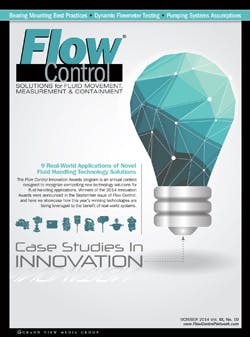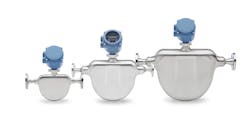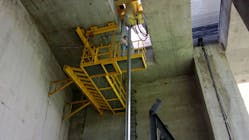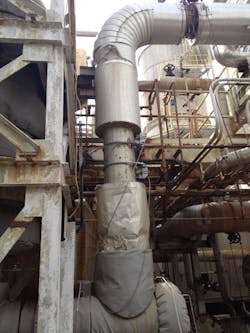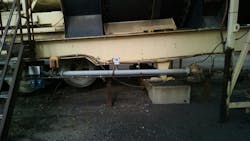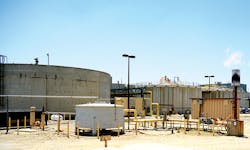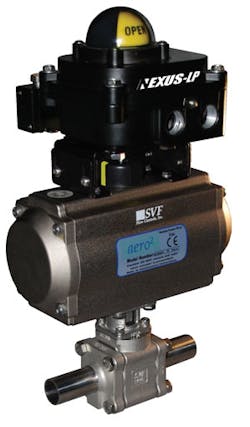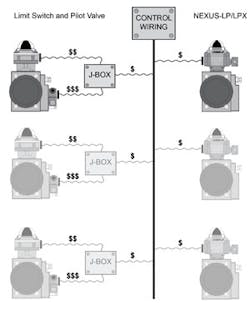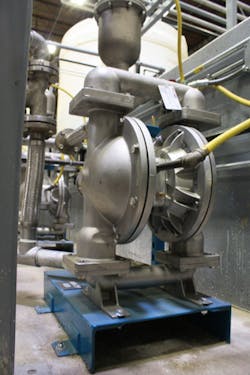The Flow Control Innovation Awards program is an annual contest designed to highlight compelling advances in fluid handling technology. The 2014 nominees were presented in the June issue of Flow Control, and open reader voting was hosted on FlowControlNetwork.com through Aug. 1. Nine winners were announced in the September issue of Flow Control, and here we provide case studies and application notes on the winning technologies, showcasing how each is being employed to the benefit of real-world systems.
READ ALSO: 2014 Innovation Awards Winners Announcement
2014 Innovation Award Winners
- Canalta Flow Measurement
- Emerson Process Management, Micro Motion
- Endress+Hauser
- FLEXIM
- Fox Thermal Instruments
- Kurz Instruments
- SVF Flow Controls
- Veris
- Wilden Pump & Engineering
Flow Conditioner Housing Cuts the Cost of Maintenance
Contour FCH Flow Conditioner Housing | Canalta Flow Measurement
Flow measurement technicians will inevitably face abnormally high or low measurement readings, be they in differential pressure-, ultrasonic- or turbine-based installations. Such readings require site assessments and corrective action to preserve metering accuracy. Suspicion that there is a problem with the flow conditioner—in the case of line- and flange-mounted units—results in the measurement site being shut in, in some cases including compressors and wells. A team of field technicians with equipment travel to the site, shut everything in, bleed the line down, break it apart, and extract the flow conditioner. Once maintenance has been performed on the flow conditioner, it is replaced, flanges are reconnected, and everything is brought back online. Though the actual cleaning or replacement of the flow conditioner may only take a few minutes, the associated procedures of blocking in, depressurizing, breaking apart, reconnecting, and bringing the metering site back online may take upwards of eight hours or more.
With a Contour FCH Flow Conditioner Housing installed, orifice-plate inspection and maintenance is carried out by a single field technician in minutes rather than hours, without breaking apart the line, and without concern for the costs described above. Labor, downtime, travel and equipment usage are all saved while at the same time improving the performance of the flow conditioner, improving the productivity of the workforce, and improving the profitability of the company.
On an 8" line upstream of an ultrasonic meter in most U.S. regions, this represents a cost savings of nearly $6,000 for every flow conditioner inspection or cleaning, not including the value of deferred gas resulting from the downtime. With a dual-chamber Contour FCH installed, speed and savings are increased even further by removing the need to depressurize. In most cases the dual-chamber Contour FCH Flow Conditioner Housing has paid for itself after only three inspection or maintenance events, and single-chamber models have paid for themselves after only a single such event.
"We really like the added diagnostic capabilities, cost savings, and reduced downtime in maintaining our overall measurement system, " said a midstream operator with a Canalta Contour FCH upstream of an orifice meter. "Keeping the flow conditioner clean is key to metering accuracy, and the Canalta Contour FCH Flow Conditioner Housing makes that very easy to do."
www.canaltaflow.comOne Coriolis Flowmeter Meets the Application Need Where Others Had FailedELITE CMFS Coriolis Flow Sensor Platform | Emerson Process Management – Micro MotionUnilever is an international manufacturer of foods and personal and household care products. The company’s Gebze production facility in Turkey is one of the world’s largest manufacturing locations for detergent, household- and personal-care products.
As part of a program to meet increased demand for its products, Unilever invested in a new automatic silicone mixer line for shampoo products at its Gebze facility. After the new mixing line was started, Unilever discovered that the Coriolis flowmeters in place (which were not Micro Motion products) were unable to measure feedstock flow because of entrained gas in the silicone and the need to operate at a vacuum of -700 mbarg. The accuracy of the blending process on the mixer line is critically important to the quality of the final products. To ensure production could continue with the best product quality, Unilever decided to use a process of weigh scales and load cells to replace the unsuccessful flow measurement system. The resulting handling, transport and storage of over 7,000 barrels of silicone per year increased production time, operating costs, and health and safety risks. Wastage was increased because 1 percent to 2 percent of the silicone was left in the empty barrels. Equipment used to handle the barrels also increased plant energy usage and costs. Most importantly, the silicone measurement accuracy from the weigh scales was lower than expected and not sufficient to meet Unilever’s exacting quality standards.
To eliminate the weighing process, Unilever required a highly accurate measurement system based on mass flow. However, the presence of entrained gas in the silicone feedstock used in the blending process made this a challenging application—as demonstrated by the failure of the previous Coriolis meters. This was compounded by the need to operate at a vacuum of -700 mbarg to help separate bubbles from the silicone and improve the quality of mixing.
Unilever had evaluated several types of Coriolis flowmeters supplied by various vendors, but these tests were unsuccessful under the extreme operating conditions. To address these issues, Emerson worked with Unilever to investigate how Micro Motion ELITE Coriolis flowmeters (not included in the previous evaluation) would perform in the same conditions. Emerson’s Micro Motion ELITE Coriolis flowmeters feature low-frequency flow sensors that increase flow accuracy in the presence of two-phase flow. MVD (multivariable digital) technology considerably improves the accuracy and stability of the Coriolis signals from the flow sensor. Enhanced signal processing, as well as sensor stability and design, ensures accurate measurements even under entrained gas conditions. After the successful completion of tests in partnership with Unilever engineers, the process of weigh scales and load cells could be eliminated, reducing operating costs by 17 percent. Product quality has improved and production time reduced by 10 percent to 15 percent. In addition, the reduced handling of the silicone feedstock has reduced health and safety issues and minimized the risk of accidental spills that could damage the environment. Based on the performance of Emerson’s Coriolis flowmeters, Unilever installed an additional 12 Micro Motion ELITE and F-Series Coriolis flowmeters at Gebze when the capacity of the line was increased with two more mixers.
The Final Results:
• Assured final product quality; enhanced health & safety
• Reduced operating costs by 17 percent
• Saved 10 to 15 percent in production time
• Reduced raw material waste by 1 to 2 percent
• Reduced energy usage
• Minimized risk of spills and environmental issues
Radar Level Sensor Effectively Monitors Flow Gate Position at Hydroelectric Plant
Micropilot FMR5X Radar Level Measurement Instruments | Endress+Hauser
By Dean Mallon, Level Product Business Manager, Endress+Hauser
The Comisión Federal de Electricidad (CFE) of Mexico operates 178 power plants that generate 51,571 MW of electric power from hydroelectric, coal-fired, geothermal and one nuclear plant scattered around Mexico. At one of the hydroelectric plants on Lake Huites, CFE was experiencing problems with the mechanical sensors measuring the position of the flow gates.
Each flow gate is raised and lowered to feed water to turbines driving the electric generator. Gate position sensing and control is critical because hydroelectric plants typically provide power during peak demand periods, and then shut down or limit generation during low demand, such as at night. The height of the gate determines water flow and directly affects power generation, so the gate may go up and down several times a day to meet power demands.
Having an unreliable gate level sensor meant the Siemens Simatic PCS7 control system didn’t know how much water was being released to the turbines. To eliminate reliability problems with troublesome mechanical sensors, CFE installed an Endress+Hauser Micropilot FMR51 radar level sensor on the gate.
The FMR51 was installed at the top of a 70-foot pipe (see photo at left) extending from a dry, safe area above the gate and water intake tunnel to the bottom of the gate. The FMR51 has a maximum measuring range of 230 feet, so the gate height was no problem.
No matter the gate position, the radar signal detects gate position with an accuracy of +/-2mm. The radar signal reflects off a metal plate attached to the control gate piston to detect gate position. The FMR51 transmits gate position, calibration information, and diagnostics to the hydroelectric plant’s control system via the Profibus PA digital communications network for consistency with the rest of the plant’s instrumentation.
CFE installed and commissioned the FMR51 itself without needing any Endress+Hauser support on site. At first, CFE used both the FMR51’s signal and the old mechanical level system’s signal to monitor gate position, but the mechanical system failed so often CFE came to rely upon the FMR51.
In fact, when the mechanical system fails, CFE’s technicians now use the diagnostic signals from the FMR51 to analyze the actual gate position versus the mechanical system’s signal. Technicians monitor the FMR51’s diagnostic signals on the HMI graphic terminals of the plant’s control system.
The FMR51 was installed in mid-January 2014 and has operated flawlessly ever since. Because of the excellent results, CFE installed the radar sensor on 13 additional gates at four other hydroelectric plants.
By Chris Hagemo, Sulfuric Acid Superintendent at the Mosaic plant in Riverview, Fla.
Mosaic is the world’s leading producer of concentrated phosphate, a key ingredient in most fertilizers. To create phosphate suitable for fertilizer, first the phosphate rock is crushed, mixed with water, and then combined with sulfuric acid in a reactor to produce phosphoric acid. Finally, the phosphoric acid is reacted with ammonia to produce ammonium phosphate fertilizer. Sulfuric acid is produced on site from molten sulfur and water.
It is in the production of the sulfuric acid that the greatest risks of leaks occur. With the phosphate/sulfuric acid process, it is critical that both the flow of the acid and its concentration are carefully monitored. The problem was that the meters Mosaic was using were intrusive and made contact with the acid flow, making them prone to failure. Even more than instrument failures, acid leaks are the biggest concern due to the safety and environmental impacts.
Mosaic has already installed several ultrasonic clamp-on flowmeters on water and gypsum lines to measure strictly flow and the company is pleased with their accuracy and reliability. When mentioning the problem of concentration monitoring, FLEXIM made Mosaic aware of their non-intrusive PIOX S concentration meters.
PIOX S uses the data gained from the ultrasonic transmission technology to perform concentration analysis during process control and to calculate the (concentration compensated) mass flowrate.
Mosaic decided to take the cautious route and installed one meter and monitored it for accuracy for a year. At the end of the year, we were satisfied with the way it tracked and saw that we might be able to eliminate most of our leak problems by getting concentration readings on the main acid lines. Mosaic now has 20 ultrasonic meters working well and sending data back in real time.
I’m pleased at how non-intrusive metering makes the job easier and the plant more efficient by reducing downtime. Before we couldn’t repair acid leaks on the run because we couldn’t run without a concentration meter. Now, even if we only use the ultrasonic as a backup to measure concentration, then we can make the repairs on the run and not have to shut down.
Accurate measurement of product production tonnage is my final goal, and I think ultrasound can give it to me. By measuring acid concentration and flow on the actual product line, we will be able to calculate the mass flowrates in real time and know exactly what we’re producing all the time.
By keeping up with the latest technology, we have not only achieved its primary goal of increased safety, but also greatly reduced downtime and will soon gain real-time control of production data.
www.flexim.com
Asphalt Producer Leverages Thermal Mass Flowmeter for Efficiency Project
Model FT2A Thermal Mass Flowmeter | Fox Thermal Instruments
Shelly Co., a subsidiary of Oldcastle Materials—the nation’s largest producer of asphalt—began an efficiency project to improve plant equipment performance, determine inefficiencies, and perform a fuel cost analysis of natural gas used in the plant. Shelly Co. recently adopted the FOX Model FT2A Thermal Mass Flowmeter and Temperature Transmitter to measure the flow of fuel to the facility’s main burner. This burner removes moisture from the aggregate by heating it. The biggest factor driving the efficiency project is that this burner may not be operating at its most efficient capacity, and improvements in burner performance will help the facility to lower production costs.
The meter from the local gas company provides a reading of all of the natural gas entering the facility, but a sub-meter was needed on the main burner to show how much of the total gas to the facility was used by the main burner in the plant. By subtracting that amount from the total gas to the facility, operators are also able to tell how much is going to the other heaters.
When looking for a flowmeter, Shelly Co. had two key needs to be met. First, the meter must have Ethernet Modbus TCP on board the meter in order to connect to the PLC. Secondly, the meter must accurately measure the flow of fuel to the main plant burner in real-time. The FT2A was chosen for its Ethernet Modbus TCP communication option, real-time measurement of natural gas, low cost, and ease of installation.
Having the ability to view meter readings from a remote location, or the PLC, was essential to the aspect of improving efficiencies. The FOX Model FT2A’s on-board Ethernet Modbus TCP communication option gave remote access to the meter to retrieve the totalizer value. This is especially important so that the plant operator needn’t be bothered when others have to check the flow; they can just go online from their computer and pull up the data. At the same time, the plant operator has the ability to get a flow measurement right into the PLC. This has allowed the team to tie the fuel readings together with the asphalt production quantities to give the plant operator an overview of production efficiencies.
The FT2A’s accurate, real-time, and direct mass flow measurement of natural gas in the fuel line of the main burner is helping to optimize what is referred to as the "BTUs per ton" of asphalt that is being produced at the plant. This is a determination of how many BTUs are used to produce a given ton of asphalt. By adding the FT2A flowmeter to the burner fuel line, they have the ability to show the flow of fuel to the burner in real-time instead of at the end of the day, or week, or month. This key feature of the FT2A (i.e., the ability to see flow in real-time) allows Shelly Co. to make adjustments in order to get better performance when it needs it most.
Wet Gas Flowmeter Key to Taming Digester Acid Phase
454FTB-WGF Thermal Mass Flowmeter | Kurz Instruments Inc.
The Inland Empire Utilities Agency (IEUA) operates and maintains four water recycling facilities and two biosolids treatment facilities. The four water reclamation facilities are designed to reclaim wastewater received from the five member agencies and have a total combined design treatment capacity of 84 million gallons per day (MGD). Regional Water Recycling Plant No. 1 (RP-1) in Ontario, Calif., was originally commissioned in 1948 and has undergone several expansions to increase the wastewater treatment capacity to the current 44.0 million gallons per day (MGD) and biosolids treatment capacity equivalent to a wastewater flowrate of 60.0 MGD. The major treatment processes include preliminary and primary treatment, primary effluent flow equalization and diversion, secondary treatment, tertiary treatment, and biosolids treatment.
The RP-1 wastewater treatment plant is a progressive plant that has been using multistage anaerobic digestion since the year 2000 to improve the efficiency of the facility. A multistage system separates a single digester process into temperature-based anaerobic digestion (TPAD) phases using multiple digesters. In the case of RP-1, the first stage digesters operates at 90-104 F (32-40 C), the second stage digesters operate at 122-127 F (50-52 C), and the third stage digesters operate at 108-110 F (42-48 C).
IEUA technical staff gave a presentation on an acid phase upset that was partially attributed to the inability of thermal flowmeters to respond effectively to changing gas production when impacted by liquid condensation from the digester. After meeting with Kurz Instruments and learning of the capabilities of the 454FTB-WGF flowmeter, IEUA agreed to test the WGF.
After a month of testing, operators questioned what appeared to them to be noise generated by the new flowmeter. After several experiments, it was determined that the meter was actually measuring the gas burping through the scum mat floating on the digester. This provided the first example of the responsive measurement capabilities of the WGF.
The second example occurred when the operators were able to prevent an upset due to vivianite buildup in the heat exchanger. As the digester temperature began to drop, gas production was immediately affected. The fast response time of the WGF allowed operators to take corrective action to prevent a situation that would have otherwise required extensive maintenance and cleanup. The previous thermal flowmeter would not recognize the changing gas production, but would instead rail out from the excess moisture, which made it impossible to prevent the impending upset.
The Kurz 454FTB-WGF flowmeter operates at a 300 C overheat, vaporizing any droplets contacting the sensor. This allows the WGF to provide a quick response for the true dry gas flow measurement within a condensing gas environment. Other thermal meters specified for wet gas environments have a sensor overheat that is incapable of stopping droplet contact with the sensor, which then requires substantial time to dry out. The varying degrees of continuous condensation make it impossible for other thermal meters to retain accuracy in digester applications.
Integrated Pilot Valve & Limit Switch Simplifies Installation and Reduces CostNEXUS-LP/LPX Integrated Pilot Valve & Limit Switch System | SVF Flow Controls, Inc.Processing facilities worldwide continue to demand automated valves that include remote control and feedback utilizing both pilot valves and position indicating switches. Typical control valve packages require control and feedback wiring to energize the pilot valve and to connect to the limit switches. Because these are independent devices, field installation is cumbersome, expensive, and adds complexity to the final system.
The NEXUS-LP builds upon SVF Flow Controls’ expertise in the development of cost-saving solutions in the field of flow control. Attention to every detail ensures that this rugged yet compact controller will endure the most challenging process environments while providing reliable and accurate control.
At the heart of this advancement is the integration of the feedback switches and pilot valve into a single enclosure, eliminating the need for a second conduit run when connecting to these devices.
The robust enclosure meets NEMA 4/4X and features a high-density polyester coating that resists a wide range of chemicals. The pilot valve is high flow with a Cv of 1.4 and may be configured for double-acting or spring-return actuators. The NEXUS-LPX is ATEX-certified for use in hazardous areas.
The NEXUS family of control products is suitable for plant-wide use, and all models are supplied with a universal mounting kit that adapts to all of the most common ISO/NAMUR pneumatic actuators.
The integration of the control elements into a single package also results in a lower initial cost. When combined with the savings in installed cost and the enclosed protection the NEXUS-LP offers the best lifetime cost of any similar method of control.
"Where we are now implementing plant-wide automation in our facility, the simplicity of the NEXUS has proven to be an excellent and strategic decision to improve overall installed cost," commented an end-user.
www.svf.net
Rocket Engine Test Facility Turns to the Accelabar for Critical Flow Measurement Application
AFS-GR Series Accelabar Flowmeter | Veris
Numerous safety measures work in tandem when a rocket is launched. Prior to a launch, critical engineering and testing is conducted to assure the integrity and safety of the launch site and the surrounding area. Fire safety is especially critical at a site surrounded by hundreds of thousands of pounds of highly combustible materials.
At a government rocket engine test facility along the Gulf Coast, flow measurement was required for extremely high pressure Nitrogen (6,200 PSI) used to purge the launch pad of combustible gasses prior to rocket testing. The flowmeters required high accuracy over a wide operating range of flowrates, pressures and temperatures. Pipe sizes ranged from 2" XXH to 8" XXH with flowrates ranging from 200 SCFM to 40,000 SCFM. Nitrogen is delivered at an extremely high velocity during startup and then reduced to 500 SCFM and lower during normal operation. The HP Series Accelabar was chosen due to its high turndown capability, accuracy, and ability to measure mass flow integral to the meter body—with no additional pipe penetrations required for pressure and temperature measurement. In addition, because the Accelabar requires no straight-run upstream or downstream of the meter, installation did not require piping additions or modifications. No other flowmeter technology could meet the requirements.
Due to the critical nature of the application, the construction of the Accelabar had to meet stringent QA requirements in accordance with ASME B31.3 including, but not limited to, code welding per ASME section IX, dye penetration testing, radiographic examination, and hydrostatic testing. Because the application exceeded a 2500# ANSI rating, the Accelabar meters were designed with special Grayloc fittings in lieu of flanges.
Veris also supplied special high-pressure theromowells, RTDS, DP transmitters and flow computers. Veris designed and built the cabinets that housed the secondary instrumentation.
Veris is the industry leader in the engineering and manufacturing of innovative custom flow measurement solutions. From high pressure/temperature applications to those requiring a variety of exotic materials, Veris is uniquely suited to match the right materials and construction for the job, even when it extends boundary of our catalog.
The aerospace industry has many demanding flow measurement applications. In the case of the Accelabar HP Series used on high-pressure gasses for flame suppression, Veris provided a solution that satisfied the user’s requirements of superior performance and bullet-proof construction with no straight-run or maintenance requirements.
In August 2013, EMCO Chemical Distributors Inc. cut the ribbon on a new corporate headquarters and distribution facility in Pleasant Prairie, Wis. The relocation came more than 40 years after EMCO began operations at its location in North Chicago, Ill., and was made for the most basic of reasons … After more than four decades of growth had made EMCO one of the 10 largest privately owned distributors, blenders and custom packagers of industrial/specialty chemicals and fine ingredients in the United States—with annual sales of more than $300 million—it had simply run out of expansion room at the North Chicago location.
The new facility is located in an old resin and ink factory and its open architecture presented Mark Serdar, EMCO’s Facilities Maintenance Manager, a blank canvas when designing the facility. So he used that opportunity to personally create a "warm room" featuring 17 storage tanks that contain a variety of chemicals, from hazardous to viscous, that require higher ambient temperatures.
To handle the unique products that would be stored in the warm room, Joe Cervantes, Pump Sales Engineer for Anderson Pump & Process, Brookfield, Wis., EMCO’s long-time pump supplier, recommended 2" Wilden Advanced Series (bolted) Stainless-Steel Air-Operated Double-Diaphragm (AODD) Pumps with the Pro-Flo SHIFT Air Distribution System (ADS), which had been released in June 2013.
"When EMCO wanted to expand, they knew us and came to me to ask my thoughts on what pumping technologies to use," explained Cervantes. "They had been using some older AODD technologies in the North Chicago plant, but we knew there were some newer diaphragm-pump technologies available that could aid in the efficiency of their operations."
Specifically, the Pro-Flo SHIFT ADS features an air control spool that eliminates the "over-filling" of the air chamber during the period from the end of each stroke to the completed shift of the valve without any corresponding fluid displacement. This elimination of wasted air allows Wilden Advanced Series bolted and Original Series clamped AODD pumps to achieve up to a 60 percent savings in air consumption over competitive AODD pump technologies for greater product yield per standard cubic foot per minute (SCFM) of compressed air used.
Since their installation, the Pro-Flo SHIFT AODD pumps have been a hit at EMCO’s new facility.
"We wanted better product containment and the Advanced Series Pro-Flo SHIFT pump has been a foolproof pump that has given us great performance with no worries," said Serdar. "We chose the Wilden SHIFT pumps because we wanted an economical fit for this application and they were the most cost-effective because of the energy savings. These pumps are the most cost-effective choice. We went with air-diaphragm pumps and we went with the best—the Wilden Advanced Pro-Flo SHIFT—because it consumes less air."
Additionally, while the Pro-Flo SHIFT ADS dramatically improves energy efficiency and overall sustainability, it also costs 50 percent less than an electronically actuated ADS, is submersible, and features plug-and-play operation with no learning required.

